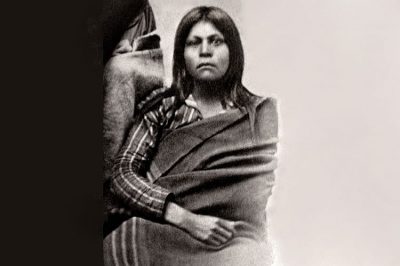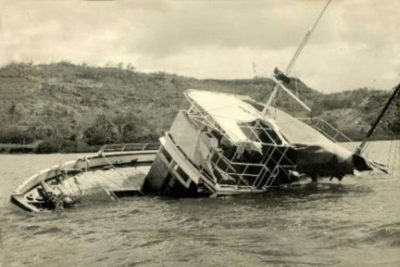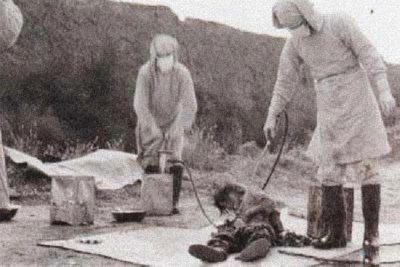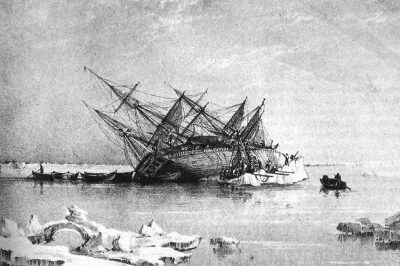The post Ada Blackjack: The Woman Who Survived Against All Odds in a Freezing Arctic Island appeared first on .
]]>
Ada Blackjack. (Wikimedia Commons)
Ada Blackjack was a 23-year-old Inupiat woman who was stranded on a remote island north of Siberia during a compromised expedition. This is her story of courage, endurance and survival which lasted over two years.
The Blackjacks: Luck was never on their side
At the young age of sixteen, Ada met her husband Jack Blackjack, a local dog musher. The young couple soon gave birth to three children. But as luck would have it, two out of their three offspring did not survive. The pain of losing their children was unbearable, and it soon affected the once happy couple. This was followed with Jack’s abandonment of Ada and their only living child, five-year-old Bennet on the Seward Peninsula in 1921. A destitute Ada, thus, began her journey. She walked about forty miles back to Nome, Alaska, her hometown, with her young son.
When Bennet would get too tired, she carried him. Soon, Bennet got afflicted with tuberculosis, and Ada could not provide enough resources that would nurse him back to health. It was at that time when she heard about an expedition on its way to Wrangel Island looking for a local seamstress fluent in English. Vowing to earn enough for her son, Ada temporarily left her son in an orphanage and joined the expedition.
A doomed enterprise
Wrangel Island is situated in the Arctic Ocean, about a hundred miles north of the Siberian coast, and over two hundred and fifty miles from Alaska. The Island is literally in the middle of nowhere and is enveloped by unbearable cold. The surrounding water is usually frozen most of the year making passage impossible. The island is desolate and of good proportions, which fell in the eye of a Canadian explorer Vilhjalmur Stefansson. He had applied to the Canadian government for possession of the island, but was rejected.
In 1921, he came up with a new plan of claiming the island for Britain. To do that, he planned to send a crew of people to the island to begin preparations. The party included Frederick Maurer, E. Lorne Knight, and Milton Galle. They even considered recruiting an Eskimo family, who would cook and maintain the camp. Although a lot of them were interested, except Ada, nobody showed up. Ada faced a lot of misgivings, which included the fact that she was being accompanied by a party of Alaskan Natives.

Ada Blackjack with the expedition crew. (Internet Archive)
The calm before the storm
On 6th September 1921, the crew set sail with six months of supplies, unaware of the disaster that would ensue. A ten-day journey later, the crew reached Wrangel Island and immediately raised the British flag, claiming the land under King George. Life on the island fell into a routine of hunting, cooking, building furniture, signing each day off with jokes and hymns. They set up meteorological instruments, and all seemed convenient except one aspect- there were not enough animals to hunt and feed on.

The camp at Wrangel Island. (Internet Archive)
The initial plan was that by the upcoming summer a supply ship would replenish their limited supplies. But an icy storm in June froze the ocean around the island, hindering access by ships. Back in Alaska, however, Stefansson could not raise enough money for a relief ship. It was not until August when one, named Teddy Bear, embarked on the journey but was a failure. The men on the island had foresight enough to ration their supplies. They had to relocate because they had used all the surrounding wood, fed on whatever they found, and soon one by one the men began to drop like flies.
The first to succumb to ill health was Knight, whom Blackjack tried to nurse back to health. Meanwhile, on January 29, the others left to find help promising to be back, but they never did. Knight eventually died on June 22nd. “There, with only a dead man as a companion, surrounded by seas of ice, Ada Blackjack wrote the real epic of the North,” reported The World magazine in 1927.
Ada Blackjack: A survivor
It was not until August 1923 when Ada finally saw the light of day. “I must stay alive,” Blackjack recalled later, was the thought which kept her going despite the adversities. She used Knight’s rifle to shoot seals to make shoe soles, read Bible, and walked on the beach to keep going through her day. She was a feeble and shy little woman, terrified of polar bears, but with unimaginable tenacity. In the three months, after the death and disappearance of her companions, she was alone and learnt how to shoot birds, trap white foxes, lookout for polar bears, crafted a skin boat out of driftwood and so much more. She threw herself in the need to survive for her son.

Left: Ada Blackjack standing. Right: Ada removing blubber from a seal. (Internet Archive)
This remarkable story of Ada’s two-year stay in the Arctic is inscribed in time as a book by Jennifer Niven by the name of Ada Blackjack: A true story of survival in the Arctic. The book documents in detail the struggle the crew underwent on the expedition in Wrangel Island due to a wilful negligent venture organized by Stefansson. As it turns out, the island had been under Russian occupation since 1916, all along the time the crew lived there. It is now a Russian wildlife refuge.
Enjoyed this article? Also, check out “Juana Maria: The Isolated Woman of the Remote San Nicolas Island“.
Fact Analysis:
STSTW Media strives to deliver accurate information through careful research. However, things can go wrong. If you find the above article inaccurate or biased, please let us know at [email protected].
RELATED
The post Ada Blackjack: The Woman Who Survived Against All Odds in a Freezing Arctic Island appeared first on .
]]>The post Juana Maria: The Isolated Woman of the Remote San Nicolas Island appeared first on .
]]>
Juana Maria. (Edwin J. Hayward and Henry W. Muzzall / Southwest Museum of the American Indian)
The Channel Islands of California are a cluster of eight islands found in the Pacific Ocean near California. A long time ago, the Native American tribes of Chumash and Tongva were once the inhabitants of these islands. They were later displaced by European settlers who started fishing and agriculture on the islands. The US Military now uses these islands for testing their weapons.
The remotest of these Channel Islands is San Nicolas, which is 98 kilometres from the nearest point on the coast, towards the west of Los Angeles. The island was once inhabited by the Native American tribe, Nicoleño. There is a famous children’s novel about a Native American girl stranded on an island in the Pacific written by renowned American author Scott O’Dell. The book, ‘Island of the Blue Dolphins’ is inspired by a Nicoleño woman Juana Maria, popularly known as the ‘Lone Woman of San Nicolas Island’. She was the last surviving Nicoleño who lived a solitary life on the island for nearly two decades.
The origins and eventual evacuation

San Nicolas Island. (US Navy)
It has been hypothesised that the Southern Channel Islands of Santa Catalina, San Clemente and San Nicolas had settlements of Native Americans for nearly 10,000 years. In 1811, a Russian-American company started doing business off the coast of California. Their business was to hunt otters and seal for their skin, which was in great demand. The company employed Alaskan sea otter hunters and Russians. These people arrived on the San Nicolas Island in 1814 and a conflict started between them and the Nicoleño tribe. The hunters brutally killed off the Nicoleño men and made the women their slaves.
In 1815, the Spanish authorities tried to take charge of the hunting of the sea otter and arrested a Russian, Boris Tasarov for the hunting expeditions. By then, not only had the sea otter population dwindled but it was also discovered that there were hardly any surviving members of the Nicoleño tribe.
Catholic missionaries soon began visiting the island and convincing the tribal people to relocate under the Catholic Church. In 1835, the Santa Barbara Mission got wind of the fact that a handful of Nicoleño people still existed on the San Nicolas Island. They dispatched a small ship called ‘Peor es Nada’, meaning ‘Better than Nothing’ to the island in an effort to get the Native Americans on shore. The events that followed though ambiguous are what led to the existence of the woman we know as Juana Maria. While the people of the island willingly climbed aboard to be relocated, it is said that a woman and a child got left behind. The captain of the ship, Charles Hubbard was in a hurry to reach Santa Barbara as a storm was brewing. The other version of hearsay is that the woman on realising that a child (either her’s or her brother’s) got left behind, jumped from the ship and swam to the island. The captain considered it was better to come back for them after the storm had passed. Later, several trips to the island were in vain, as that woman and child could not be found again.
The discovery of Juana Maria
Over the years, sailors claimed to have seen a woman on the island while passing and the legend grew. However, in 1850, an otter hunter went to San Nicolas and stated that he had come across a hut on the island. Soon after, the Mission Santa Barbara sent a local to look for her on the island, but in vain. Piqued by the legend of the lone woman of San Nicolas Island, American sailor, George Nidever decided to visit the island in 1853 determined to find her. He embarked on a mission to the island to look for her while hunting for otters also. Unfortunately, he failed to locate her in his first two trips. On the third attempt, a member of Nidever’s team, Carl Dittman came across human footprints and crude tools along the beach. Shortly afterwards, Nidever and his men found her nearby and tried to initiate a conversation with her, fruitlessly. With the inability to understand her language, they started calling her ‘Better than nothing’, after the ship that she had missed 18 years ago.
She keenly showed the men around the island and helped them find freshwater for drinking. Their stay with her revealed her way of living alone and surviving for all those years on the island. According to George Nidever, she explained by gestures that the child she had gone back for had been killed several years ago by wild dogs. She had survived on seafood and seals which she killed with the crude tools that she had made herself. She showed them her various hiding sites, caves and canyons, where she kept herself safe from invaders. Finally, when Nidever decided to head back to Santa Barbara, she willingly accompanied the crew back home.
The spectacle of Santa Barbara
Back in Santa Barbara, she was taken care of by Nidever’s wife, Sinforosa Sanchez Nidever. No one was able to understand her language, which resulted in no knowledge about her tale of 18 years as a lone survivor on the island. She soon became famous and tourists thronged to see her. The newspapers frequently wrote about her adjustment with a civilised lifestyle. The people of the mission tried to get Native Americans to listen to her songs in an effort to find someone who knew the language and could help with the true identity and 18-year-old story of the woman, but to no avail.
She did not seem to mind the attention that she got from the people around or those visiting. She graciously accepted gifts that were given to her and generously distributed them among George Nidever’s children. Linguists were unable to determine her dialect and wondered if the language that she spoke in, was one that she herself had invented. Soon, the Santa Barbara Mission decided to name her in order to give her an identity. Unfortunately, she fell ill with dysentery and passed away seven weeks from arriving at the mainland on October 19 in 1853. She was baptised the same day as Juana Maria.
Enjoyed this article? Also, check out “Vesna Vulovic: The Woman who Plummeted from 33,000 Feet and Survived“.
Recommended Read:
Island of the Blue Dolphins | By Scott O’Dell
Fact Analysis:
STSTW Media strives to deliver accurate information through careful research. However, things can go wrong. If you find the above article inaccurate or biased, please let us know at [email protected].
RELATED
The post Juana Maria: The Isolated Woman of the Remote San Nicolas Island appeared first on .
]]>The post A Tale of Resilience: Poon Lim, the Chinese Sailor who Survived 133 Days Castaway in the Atlantic Ocean appeared first on .
]]>
Photo of Poon Lim and his raft. (U.S. Navy)
There have been countless remarkable stories of people getting lost at sea. While some of these stories are mere works of fiction, others are tales of real people going adrift in the open waters, surviving only on bare necessities available to them. One such real-life, awe-inspiring story is that of a Chinese sailor named Poon Lim, who worked on board an armed British trading vessel that was sunk by a German military submarine in the year 1942.
As the German submarine struck the British merchant ship during World War II, Poon Lim, who worked as a steward, jumped into the South Atlantic Ocean with nothing but a life jacket. He drifted in the open ocean on a life raft for a hundred and thirteen days until a Brazilian fishing boat eventually found him and rescued him.
The escape from China
In 1932, the Imperial Japanese Army was advancing towards China in an effort to capture certain provinces of China under the Japanese Empire. Young Chinese boys were getting inducted into the army to fight the enemy. Lim’s father being worried sent him to his brother who was working on a British passenger ship. Lim enrolled with the British Merchant Navy and started working as a cabin boy.
Life at sea wasn’t easy for young Lim, who had to constantly deal with sea sickness and racial discrimination. The British were known to ill-treat those they thought were beneath their stature. Unfortunately, the Chinese crew members were not only ragged and subjected to bigotry by the British officers, but also put up in congested living quarters. Tired of the agonising treatment, Lim quit in 1937 and went to Hong Kong to pursue studies in mechanics.
Life wasn’t easy there either, with the threat of Japanese attack impending. By the time World War II broke out, the British were faced with a manpower shortage aboard their ships. The conditions by then were much better, especially for the Chinese workers, and an increased pay was now being handed out to them. Just as the Japanese were on the brink of attacking Hong Kong in 1941, Lim secured himself a job as a second mess steward on a British merchant navy ship, the SS Benlomond.
The marine misadventure
History has stated the use of cruise liners as camouflaged warships during World War I and II, these merchant ships were armed with guns, torpedoes and other weapons of combat. As a defence mechanism, the British shipping companies had been asked to design fast moving steamers with the provision for loading artillery. At the outbreak of World War II, SS Ben Lomond was sailing as an armed British merchant ship. On November 10, the ship set sail from Cape Town in South Africa, towards Paramaribo in Suriname along the northeastern coast of South America 1942. The norm during the war for ships was to sail in a fleet with an armed forces escort to enable better defence during a surprise attack. Unfortunately, SS Benlomond was sailing unaccompanied with a crew of 54, which included the master of the ship Capt. John Maul, 8 gunmen, Lim Poon, and 44 other crewmen.
13 days later, the armed merchantman was attacked by a German undersea boat (submarine) U-172 which was under the command of Kpt.Lt. (Capt. Lt.) Carl Emmermann. SS Ben Lomond was hit by two torpedoes on November 10, 1942, and vanished under water within minutes. The ship at that time was 6 days away from its destination, approximately 1200 km east of the Amazon river. Poon Lim managed to get hold of a life jacket and jumped off the ship just as the explosion in the engine room occurred.
Poon Lim’s survival at sea
Lim floated in the ocean for a rough two hours till he came across a wooden raft. He climbed aboard the 8 by 8 inches raft, which later turned out to be a Carley raft (life raft). The Carley raft was a small, square, floating platform commonly used by warships. He found some provisions on the raft which included a forty litre jug of water, tins of biscuits and crackers, some pemmican which is like a beef jerky, a bagful of sugar lumps, tablets of malted milk, lime juice, some chocolate, a couple of signal flares, two smoke signal pots and a flashlight.
By now, Lim was not sure if there had been any other survivors as he could not see anyone around. He hoped that the docking port would set out in search of the missing ship but soon realised it may not be possible in the present war-like situation. The initial days went by conveniently with the water and ration found on board. But soon after the supplies depleted, and Lim had to think innovatively to stay alive. He used the covering of his life jacket to catch rainwater for drinking and resourcefully turned a wire from the flashlight into a fishing hook. He used the hemp rope available as a fishing line, having made a sturdier hook for bigger fish out of a nail in the wooden raft. Lim was not a good swimmer so he always kept himself tied to the raft with a rope around his wrist. He managed to make a knife out of a tin container of biscuits, which he used to cut and clean the fish he caught. He often dried the leftover fish for later use.
At one point of time, after being hit by a storm, Lim was left with no drinking water, dried fish or food supply. He then caught a seagull, killed it with his crude knife and drank its blood to quench his thirst. If this was not harrowing enough, Lim noticed several sharks circling the raft time and again. Determined to survive, he decided to take on a smaller shark, to deter the others away and also because it would supply him with food for a couple of days. A feeble Lim was soon losing the strength to hunt for fish or seagulls every day. Using the remains of a seagull as bait, he managed to hook in a small shark. Once aboard, he struggled to completely kill it. After a little fight, he managed to restrain the shark enough to cut it open. Not only was he able to satiate his thirst but also had ample food for the next couple of days. He was also creative enough to clean the fins and hang them on a rope in the sun for making the popular Hainan delicacy, dried shark fins.
Passersby, sightings, and rescue
Poon Lim was apparently, sighted adrift a number of times but to no avail. The first time he was sighted, was by a ship where the crew saw him but ignored his presence. Lim concluded that it was, perhaps due to his likeness to the Japanese that he was avoided. The second time, he was spotted by US Navy patrol planes and one even dropped a buoy next to him as a marker. But Lim’s bad luck had still not run out. A storm moved Lim’s raft far away from the marker buoy and he couldn’t be traced. Sometime later, he was spotted by a German U-boat but was left to his fate. He kept a count of days by tying knots in a rope initially, but soon gave that up and resorted to counting full moons for keeping score of the number of days passed.
Lim knew a few days before his rescue that he was nearing land as the colour of the water had changed. On April 5, 1943, the raft was in a river inlet when he was spotted by three fishermen, 16 km off the coast of Brazil. They rescued him off the raft and took him into their boat. Due to the language barrier, neither party could form a comprehensive conversation. Lim was fed on the boat and taken to Belem in Brazil, arriving three days later. Though he had lost nearly 9 kg at sea, he walked out of the boat without any assistance. He was able to narrate his ordeal in Belem and was admitted in the local hospital for four weeks. He was treated for dehydration and severe sunburn. Lim Poon had been adrift for 133 days till the day he was rescued by the fishermen.
The homecoming
His return to London was organised by the British Consul in Brazil via Miami and New York. He had become a celebrity by now and people thronged to him to hear about his adventure. When he was told that he had created a record of surviving on a raft, he said, “I hope no one will ever have to break that record“. He returned to London where King George VI conferred upon him the British Empire Medal (BEM) for his courage. His experience was catalogued by the Royal Navy in survival manuals for inspiration and practical purposes.

Poon Lim with the US Navy being presented with tempered glass signaling mirror as part of rescue equipment. (National Museum of the U.S. Navy / Flickr)
Poon Lim eventually settled in the United States, where Washington Senator Warren Grant Magnuson granted him citizenship under special consideration. Poon Lim breathed his last on January 4, 1991, in Brooklyn.
Enjoyed this article? Also, check out “1972 Andes Plane Crash – The Descent to Cannibalism“.
Recommended Read:
Sole Survivor: The True Account of 133 Days Adrift | By Ruthanne Lum McCunn
Fact Analysis:
STSTW Media strives to deliver accurate information through careful research. However, things can go wrong. If you find the above article inaccurate or biased, please let us know at [email protected].
RELATED
The post A Tale of Resilience: Poon Lim, the Chinese Sailor who Survived 133 Days Castaway in the Atlantic Ocean appeared first on .
]]>The post Vesna Vulovic: The Woman who Plummeted from 33,000 Feet and Survived appeared first on .
]]>
Vesna Vulovic, when she worked as a stewardess. (File Photo)
Verna Vulovic cheated death one fine day and lived to tell her horrific tale. She was a Serbian flight attendant, who came hurtling down towards the earth from 33,000 feet above and still survived the deadly fall. Vesna Vulovic was travelling in a plane, which crashed mid-air, killing all people on board, except her. In the year 1985, she was inducted into the Guinness Book Of World Records for uniquely holding the record for the highest fall survived without a parachute.
Born in Belgrade in 1950, the 22-year-old Vesna Vulovic, who was mistaken for another stewardess with the same name, was asked to report on duty on January 26, 1972. The Yugoslav Airlines Douglas DC-9 was flying from Stockholm to Belgrade, with stopovers at Copenhagen in Denmark and Zagreb in Croatia. Vesna, who was in Denmark at that time, got on the scheduled flight from Copenhagen and was the main stewardess onboard. The plane exploded mid-air while flying over Czechoslovakian airspace and came down like a ball of fire. All the people on board lost their lives on impact, except Vesna, who was later found alive in a snow-clad mountain screaming out for help.
The flight attendant was rushed to a hospital, where due to haemorrhage, she slipped into coma and later in a vegetative state. Apart from a broken skull, Vesna had also severely fractured several bones of her vertebral column, her ribs, both her legs and her pelvis. Her injuries were so grave that she was paralyzed below her waist and couldn’t move. She also suffered from memory loss. As months passed, she was flown down to a hospital in Prague, where she began responding to treatment and showed slow signs of recovery.
Cause of aircraft explosion
When investigations of the plane crash began, astounding evidence came to light. Safety investigators believed that a home-made briefcase bomb was the cause of the explosion, which had brought down the plane. It was believed to have been planted by extremists from Croatia, who had gone unnoticed when they carried out the procedure at Copenhagen. They also believed that Vesna was trapped between the catering cart towards the rear end of the fuselage, preventing her from being sucked out of the aircraft. Although the crash was suspected to be a bomb blast mid-air, there were no traces of suspects neither were any arrests made post the investigation.
Vesna Vulovic’s recovery and survivor syndrome
Vesna made a surprising full-recovery during her retreat in Montenegro, where she was constantly under medical care and her sixteen-month-long period of revival was not easy to come by. The flight attendant later took up a desk job with the same airline company and was never scared to board a plane despite the mishap.
When news agencies contacted her after she was back on her feet, albeit with a limp, which stuck with her till the end of her life; she only recalled waking up in a hospital bed. She admitted that she was struggling with survivor’s guilt and said in an interview that rather than turning to therapy, her interest in religion became more profound, which helped her come out of her shell. Despite having survived miraculously, while her fellow passengers died, she alienated herself from the rest of the world.
During her later years, Vesna actively campaigned for the Democrats and played a major part in getting her country entry into the European Union. She lived the last few years of her life alone after her marriage did not work. She was found dead in her apartment in December 2016, with no official report of the cause.
Enjoyed this article? Also, check out “Juana Maria: The Isolated Woman of the Remote San Nicolas Island“.
Fact Analysis:
STSTW Media strives to deliver accurate information through careful research. However, things can go wrong. If you find the above article inaccurate or biased, please let us know at [email protected].
RELATED
The post Vesna Vulovic: The Woman who Plummeted from 33,000 Feet and Survived appeared first on .
]]>The post 1972 Andes Plane Crash- The Descent to Cannibalism appeared first on .
]]>
Replica of Uruguayan flight 571 used in the 1993 biographical film Alive. (Pedro Escobal / Wikimedia Commons)
Surviving a plane crash may seem like a lucky escape. But not crash-landing deep into the South American Andes, the longest mountain range on Earth. This was the story on October 13th, 1972, when a small aircraft went down between the border of Chile and Argentina. It left 27 Uruguayan survivors who found no civilization in sight, periods of up to fourteen hours of darkness and temperatures as low as -35 ºF.
An already hopeless situation, an avalanche would soon worsen matters and before long they had to resort to cannibalism. It would not be until three days before Christmas when the aircraft wreckage was finally found, but… how could it possibly contain any survivors?
The ill-fated flight
The reason for the journey was a rugby match. A small Fairchild plane was chartered from Uruguay to Chile; onboard were 45 players and supporters. Unknown was the poor safety records of the company and when the pilots believed they had already passed the Andes, disaster struck.
The passengers felt something was wrong as they could see the peaks of the mountains very close. After some strong turbulence, one of the wings clipped a peak creating an explosion. The plane plummeted dramatically and sent the cabin tobogganing down a mountain. When the survivors came to a mental discernment, they saw a gigantic landscape wrapped in a ferocious blizzard. Some commented that they felt like insects among it.
Survival after the crash
A detailed account of the experience comes from Roberto Canessa, at the time a 19-year-old medical student. He quotes himself as being dropped from a life of privilege to absolute chaos, something like a scene from a horror movie. The corpses of many of the 18 victims – families and friends included – strewn around them.
They had limited food, drink, and clothes, while they had to use the broken fuselage as cover from the elements. Another student, Fernando Parrado gives his version of events. This was after being presumed dead for three days. Doctors later said that because he was left outside the plane, the icy temperatures preserved his brain from further injury. These two would become the main protagonists within the group. (Especially after Rugby captain Marcelo Pérez passed away).
Instinctively they tried to help as many people as possible. Using tactics which included melting snow through metal sheets into bottles, rationing food and organizing hikes around the mountain. They found as many extra materials as possible to shield from the cold and used others to form a massive cross and SOS, hoping to be spotted from above. This was impossible mainly due to the aircraft exterior being white, even with a commercial flight path above them. Each passing plane teased them more than the last.
Resorting to cannibalism
Nine days after the crash, things would get even more extreme. More people began to die due to the cold and lack of food. Hunger pangs began to dominate. Eating parts of the aircraft such as the material in the seats did not sustain them. They would have to think of an inhuman thought. But after what felt so long outside of humanity, they were no-one longer be thinking like humans.
Everyone started probing the same idea once their food sources ran out but they were unable to follow through. So they turned to God. A devout religious group of Roman Catholics asked God for guidance. One of the members Javier recited a New Testament verse, relating to Holy Communion:
“He who eats of my flesh and drinks of my blood will have eternal life. Take and eat, this is my body.”
The deciding factor for many including Nando Parrado was that they would have offered themselves if the shoe was on the other foot. Nando stated that it should not be called cannibalism but rather Anthropophagy – the eating of flesh – as they were forced to do it. Four of the men used razor blades and broken glass to rip open the skin. They would survive for longer solely for that reason. Apart from one man who was too repulsed to continue.
The rescue
Six days later, when the Uruguayans thought it couldn’t get any worse a strange noise came from above. An avalanche rocked the mountain and swept through the group to create an even more desperate situation. More died and the remaining survivors were stuck in the buried cabin for three days.
On another expedition, Robert found the tail of the plane which had more clothes, drink, some sugar and a camera. Robert found his luggage which smell must have been the most bittersweet, nostalgic feeling. Perhaps it gave him more inspiration to try and see home again. Back at the aircraft, news came from the outside world. Their transistor radio gave the information that the rescue search had been called off. At this stage, they started going on deeper missions to try and find help however the air was so thin and the snow so deep that it was impossible to get far.
They were running out of flesh and time. Roberto, Nando and one other made the decision to find help. Nando’s main reason was that two of the untouched dead bodies left were of his mother and sister – who had both died on impact. As Christmas approached Nando Parrado and Roberto Canessa would be the two to venture out and never return until they found help, or die trying.
The last words of the dying co-pilot made them believe they were closer to Chile. They would only have to climb one peak before they reached green pastures. In actual fact, they were on the other side, in Argentina. So it would take ten days of intense travelling: over 15 KM, climbing peaks as much as 15,000 feet and in snowshoes made from plane seats as well as sleeping bags made from cabin insulation.
After countless hours of hardship, they started to see colours; some grass and flowing rivers. Eventually, they found a figure in the distance. An Arriero – transporters who ride mules – and told him their story. They were saved! The Arriero rode ten hours to the nearest town and organized helicopters to ascend the Andes. Because of the weather, it would take two trips to get everyone home. Rescue teams stayed with the second group.

Roberto and Parrado after being discovered in Chile. (Hector Maffuche / Wikimedia Commons)
After spending 72 days on the mountain in total, 16 survived. It became and remains one of the most famous and inspirational survival stories in human history. Those who left the mountain all led healthy lives after the torment and met every year on December 22nd to honour the dead and celebrate life.
Roberto Canessa and Nando Parrado – the ones who showed the most courage of all return to the site every year. There is a grave marked there for the victims including Nando’s mother and sister, he also named the highest peak after his father – Mount Seler. Both men return to the point where they were rescued also, keeping in touch with their saviour – the Arriero – Sergio Catalan, to reminisce about a truly heroic story.

Flight 571 crash site. (Boomerkc / Wikimedia Commons)
A story about how resolute humans can be. Why we are still alive on this planet today after thousands of years and will be for thousands of years to come. Even after hardships such as these.
Enjoyed this article? Also, check out “A Tale of Resilience: Poon Lim, the Chinese Sailor who Survived 133 Days Castaway in the Atlantic Ocean“.
Recommended Reads:
1. Miracle in the Andes: 72 Days on the Mountain My Long Trek Home | By Nando Parrado
2. I Had to Survive: How a Plane Crash in the Andes Inspired My Calling to Save Lives | By Dr. Roberto Canessa & Pablo Vierci
3. Alive: The Story of the Andes Survivors | By Piers Paul Read
Recommended Watch:
1. Alive (1993)
2. I Am Alive: Surviving the Andes Plane Crash (2010) | History Channel
Recommended Visit:
1. Andes Tragedy and Miracle (1972) Museum | Uruguay
Fact Analysis:
STSTW Media strives to deliver accurate information through careful research. However, things can go wrong. If you find the above article inaccurate or biased, please let us know at [email protected].
RELATED
The post 1972 Andes Plane Crash- The Descent to Cannibalism appeared first on .
]]>The post The Greatest Survivor, Hugh Glass appeared first on .
]]>
Hugh Glass: Illustration published in the newspaper at the time of the incident. (Wikimedia Commons)
Humans are all built from the same materials. While a few might have a golden tooth or two, we are all made up of flesh and bones. There is something in all of us that makes us equally similar and different from one another. Though, some of these qualities seem to be quite rare. Not everybody can weather the extreme conditions of the Himalayas to scale Mt. Everest, swim across the freezing cold English Channel, or survive a solo boat trip around the world. You can have all the necessary skills to achieve any of these feats but is that ever enough? These people are driven by a burning desire to etch their names in the pages of history. Their will to endure and survive whatever comes their way is unparalleled.
But not everybody does such extraordinary things just for the fame. Sometimes, making it out alive in a near-fatal situation is the only driving force for people to keep fighting. At least that was the case with the mountain man Hugh Glass, born in Pennsylvania in 1783, Hugh was an animal trapper and fur trader. He was left to die by the members of his group of explorers after being severely wounded by a grizzly bear.
For most people who have watched Leonardo di Caprio starrer The Revenant, Hugh Glass is a familiar name. The legendary explorer will be an inspiring story for generations to come.
A series of unfortunate events
This story of human spirit, unformidable will to live and sheer compassion began with an advertisement in Missouri Gazette and Public Advertiser by General William Henry Ashley. This advertisement invited a crowd consisting of 100 men to “ascend the river Missouri” for a fur-trading venture. This venture began in 1822, but Glass became a part of it in 1823 and the group of people later came to be known as “Ashley’s Hundred”.
When ascending the river Missouri in June 1823, this group was attacked by an Indian tribe called Arikara warriors during which Glass was shot in the leg. After this attack, the party decided to return to Fort Kiowa. The party then disbanded into several groups and headed west.
One of these groups, that Glass was a part of, was led by Andrew Henry and had set out to the Yellowstone River. When hunting for food for the expedition somewhere in present-day South Dakota, Glass accidentally ended up disturbing a grizzly bear with two cubs. The mother bear overcome with motherly instincts attacked Glass and wounded him badly, biting and lacerating his flesh.
Although Glass had managed to kill the bear with the help of his friends, the wounds left by the bear were severe enough for others in the group to believe that he will not make it back alive. Assuming Glass would die soon, Andrew Henry asked for two volunteers to stay back with Glass until he died and then conduct the last rituals and bury him. Two people, a young man called “Bridger” and a man by the name of John Fitzgerald, agreed to stay back as the party moved on. They had begun digging a grave for Glass, but citing an attack by Arikara, they both fled with the rifle, knife and other equipment belonging to Glass. They met with the rest of the party wrongly informing them of Glass’s death.

Another illustration of Hugh Glass being attacked by a bear from the Milwaukee Journal. (The Milwaukee Journal / Wikimedia Commons)
Against all odds
The gravely injured Glass lay there alive in his half-dug grave covered in the bear hide, eventually regaining consciousness only to find himself alone and abandoned without any weapons and equipment. His wounds had begun to fester, his ribs had been exposed due to the deep cuts on his back and he was rendered motionless by the fractures to his limbs. The nearest American settlement was 200 miles from where Glass lay dying.
Would you believe if you were told Glass made it out of there alive on his own? We wouldn’t be telling this story if he had not, but it is still shocking and surprising to hear that he did. He crawled back to Fort Kiowa, even built a rag-tag raft to float in the Cheyenne River. It took him a total of 6 weeks, surviving on wild berries and roots, to crawl to Fort Kiowa. He put maggots in his wounds to eat dead infected flesh to survive. The things he had to endure would have made most people just give up and accept their fate.
Upon his recovery, Glass set out to find the two men who left him to die and stole his rifle and equipment, Bridger and Fitzgerald, in order to avenge being left behind without his rifle. But interestingly, when he did find them, he decided to forgive them. He decided not to kill Bridges owing to his young age. Fitzgerald had gone on to join the army, Glass asked him to stay in the army or he would kill him. In the end, Glass did at least get his rifle back from Fitzgerald and a 300$ compensation.
Glass, presumably the greatest survivor on this planet, was eventually killed in an attack by Arikara during another expedition in 1833.
Enjoyed this article? Also, check out “Andrée’s Arctic Balloon Expedition of 1897: A Peek into the Doomed North Pole Flight“.
Recommended Read:
The Revenant: A Novel of Revenge | By Michael Punke
Recommended Watch:
The Revenant (2015)
Recommended Visit:
Museum of the Mountain Man | Pinedale, Wyoming (U.S)
Fact Analysis:
STSTW Media strives to deliver accurate information through careful research. However, things can go wrong. If you find the above article inaccurate or biased, please let us know at [email protected].
RELATED
The post The Greatest Survivor, Hugh Glass appeared first on .
]]>













